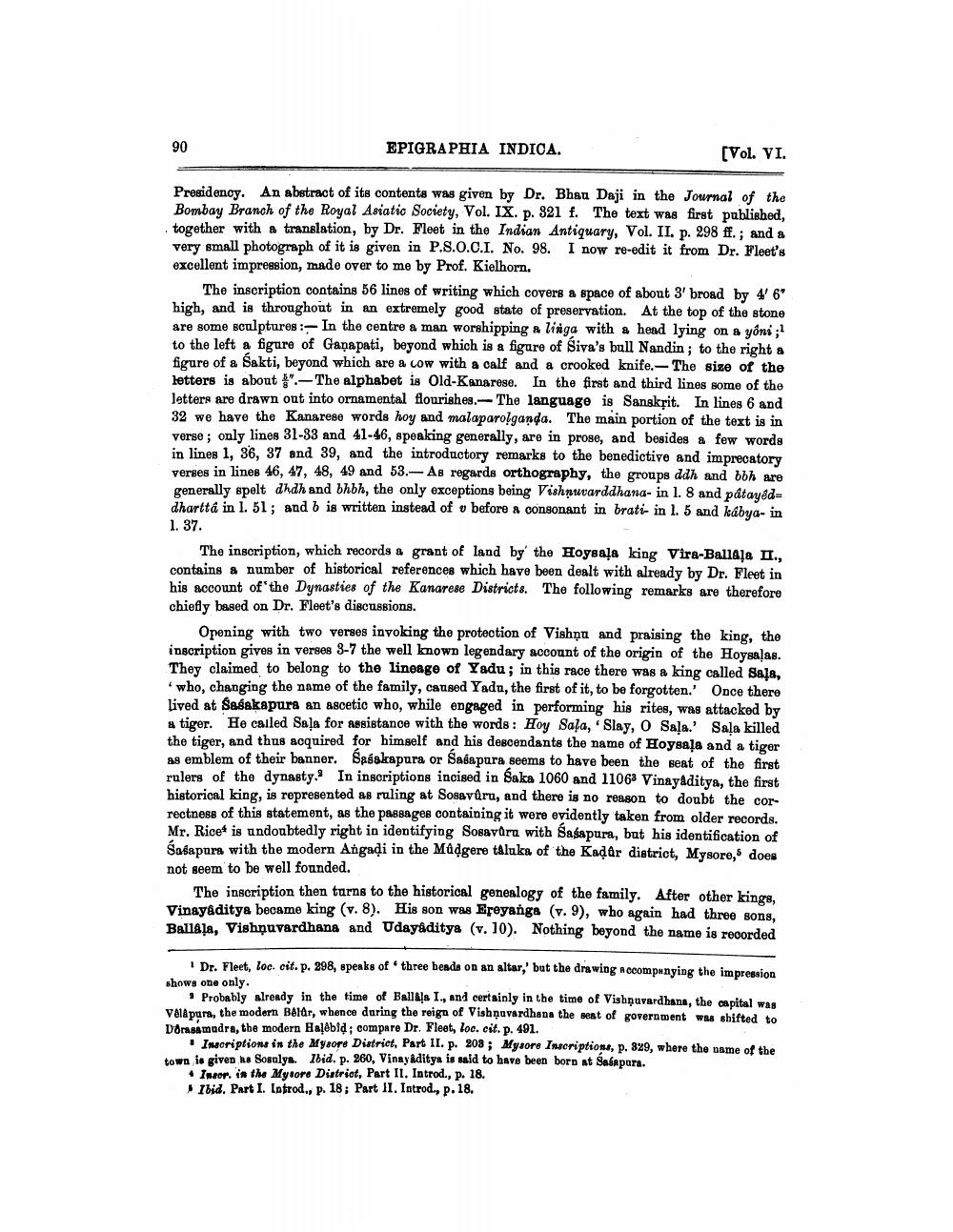________________
90
EPIGRAPHIA INDICA.
[Vol. VI.
Presidency. An abstract of its contents was given by Dr. Bhau Daji in the Journal of the Bombay Branch of the Royal Asiatic Society, Vol. IX. p. 321 f. The text was first published, together with a translation, by Dr. Fleet in the Indian Antiquary, Vol. II. p. 298 ff.; and a very small photograph of it is given in P.S.O.C.I. No. 98. I now re-edit it from Dr. Fleet's excellent impression, made over to me by Prof. Kielhorn.
The inscription contains 56 lines of writing which covers a space of about 3' broad by 4' 6" high, and is throughout in an extremely good state of preservation. At the top of the stone are some sculptures:- In the centre a man worshipping a linga with a head lying on a yoni;1 to the left a figure of Ganapati, beyond which is a figure of Siva's bull Nandin; to the right a figure of a Sakti, beyond which are a cow with a calf and a crooked knife.-The size of the letters is about ".-The alphabet is Old-Kanarese. In the first and third lines some of the letters are drawn out into ornamental flourishes. The language is Sanskrit. In lines 6 and 32 we have the Kanarese words hoy and malaparolganda. The main portion of the text is in verse; only lines 31-33 and 41-46, speaking generally, are in prose, and besides a few words in lines 1, 36, 37 and 39, and the introductory remarks to the benedictive and imprecatory verses in lines 46, 47, 48, 49 and 53.- As regards orthography, the groups ddh and bbh are generally spelt dhdh and bhbh, the only exceptions being Vishnuvarddhana- in 1. 8 and pâtayeddhartta in 1. 51; and b is written instead of v before a consonant in brati- in 1. 5 and kabya- in 1. 37.
The inscription, which records a grant of land by the Hoysala king Vira-Ballēļa II., contains a number of historical references which have been dealt with already by Dr. Fleet in his account of the Dynasties of the Kanarese Districts. The following remarks are therefore chiefly based on Dr. Fleet's discussions.
Opening with two verses invoking the protection of Vishnu and praising the king, the inscription gives in verses 3-7 the well known legendary account of the origin of the Hoysalas. They claimed to belong to the lineage of Yadu; in this race there was a king called Saja, who, changing the name of the family, caused Yadu, the first of it, to be forgotten.' Once there lived at Sasakapura an ascetic who, while engaged in performing his rites, was attacked by a tiger. He called Sala for assistance with the words: Hoy Sala, Slay, O Sala.' Sala killed the tiger, and thus acquired for himself and his descendants the name of Hoysala and a tiger as emblem of their banner. Sasakapura or Sasapura seems to have been the seat of the first rulers of the dynasty. In inscriptions incised in Saka 1060 and 11063 Vinayaditya, the first historical king, is represented as ruling at Sosavaru, and there is no reason to doubt the correctness of this statement, as the passages containing it were evidently taken from older records. Mr. Rice is undoubtedly right in identifying Sosavara with Sasapura, but his identification of Sasapura with the modern Angadi in the Mâdgere taluka of the Kadar district, Mysore,5 does not seem to be well founded.
The inscription then turns to the historical genealogy of the family. After other kings, Vinayaditya became king (v. 8). His son was Ereyanga (v. 9), who again had three sons, Ballala, Vishnuvardhana and Udayaditya (v. 10). Nothing beyond the name is recorded
1 Dr. Fleet, loc. cit. p. 298, speaks of three heads on an altar,' but the drawing accompanying the impression shows one only.
Probably already in the time of Ballala I., and certainly in the time of Vishnuvardhana, the capital was Valapura, the modern Bélár, whence during the reign of Vishnuvardhana the seat of government was shifted to Darasamudra, the modern Halêbiḍ; compare Dr. Fleet, loc. cit. p. 491.
Inscriptions in the Mysore District, Part II. p. 203; Mysore Inscriptions, p. 329, where the name of the town is given as Sosulys. Ibid. p. 260, Vinayaditya is said to have been born at Sasapura.
Insor. in the Mysore District, Part II. Introd., p. 18.
Ibid. Part I. Introd., p. 18; Part II. Introd., p. 18.




